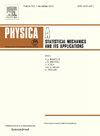探索具有对角无序和远程跳变的圆柱形N × N折叠网络的局域性
IF 3.1
3区 物理与天体物理
Q2 PHYSICS, MULTIDISCIPLINARY
Physica A: Statistical Mechanics and its Applications
Pub Date : 2025-04-11
DOI:10.1016/j.physa.2025.130514
引用次数: 0
摘要
在这项工作中,我们采用逆幂方法(IPM),一种在线性代数中成熟的技术,来研究在独特几何设置中的单电子哈密顿量的量子动力学。具体地说,我们考虑一个二维N×N晶格折叠成一个圆柱拓扑结构,结合对角无序和具有幂律衰减的远程跳变。与考虑二维平面晶格的传统研究不同,我们的模型明确地结合了圆柱形几何的曲率,使我们能够检查其对电子特性的潜在影响。通过分析无序、远程跳变和系统固有曲率之间的相互作用,我们的结果表明几何可能在电子的局域化和输运行为中起作用。这些发现提供了几何因素如何影响量子系统的见解,对材料科学和纳米结构具有潜在的影响。本文章由计算机程序翻译,如有差异,请以英文原文为准。
Exploring localization properties in a folded N x N network on a cylinder’s shape with diagonal disorder and long-range hopping
In this work, we employ the inverse power method (IPM), a well-established technique in linear algebra, to investigate the quantum dynamics of a one-electron Hamiltonian in a unique geometric setup. Specifically, we consider a two-dimensional lattice folded into a cylindrical topology, incorporating diagonal disorder and long-range hopping with a power-law decay. Unlike conventional studies that consider two-dimensional planar lattices, our model explicitly incorporates the curvature of the cylindrical geometry, enabling us to examine its potential influence on electronic properties. By analyzing the interplay between disorder, long-range hopping, and the system’s intrinsic curvature, our results suggest that geometry may play a role in the localization and transport behavior of electrons. These findings provide insights into how geometric factors could affect quantum systems, with potential implications for materials science and nanostructures exhibiting curved geometries.
求助全文
通过发布文献求助,成功后即可免费获取论文全文。
去求助
来源期刊
CiteScore
7.20
自引率
9.10%
发文量
852
审稿时长
6.6 months
期刊介绍:
Physica A: Statistical Mechanics and its Applications
Recognized by the European Physical Society
Physica A publishes research in the field of statistical mechanics and its applications.
Statistical mechanics sets out to explain the behaviour of macroscopic systems by studying the statistical properties of their microscopic constituents.
Applications of the techniques of statistical mechanics are widespread, and include: applications to physical systems such as solids, liquids and gases; applications to chemical and biological systems (colloids, interfaces, complex fluids, polymers and biopolymers, cell physics); and other interdisciplinary applications to for instance biological, economical and sociological systems.

 求助内容:
求助内容: 应助结果提醒方式:
应助结果提醒方式:


